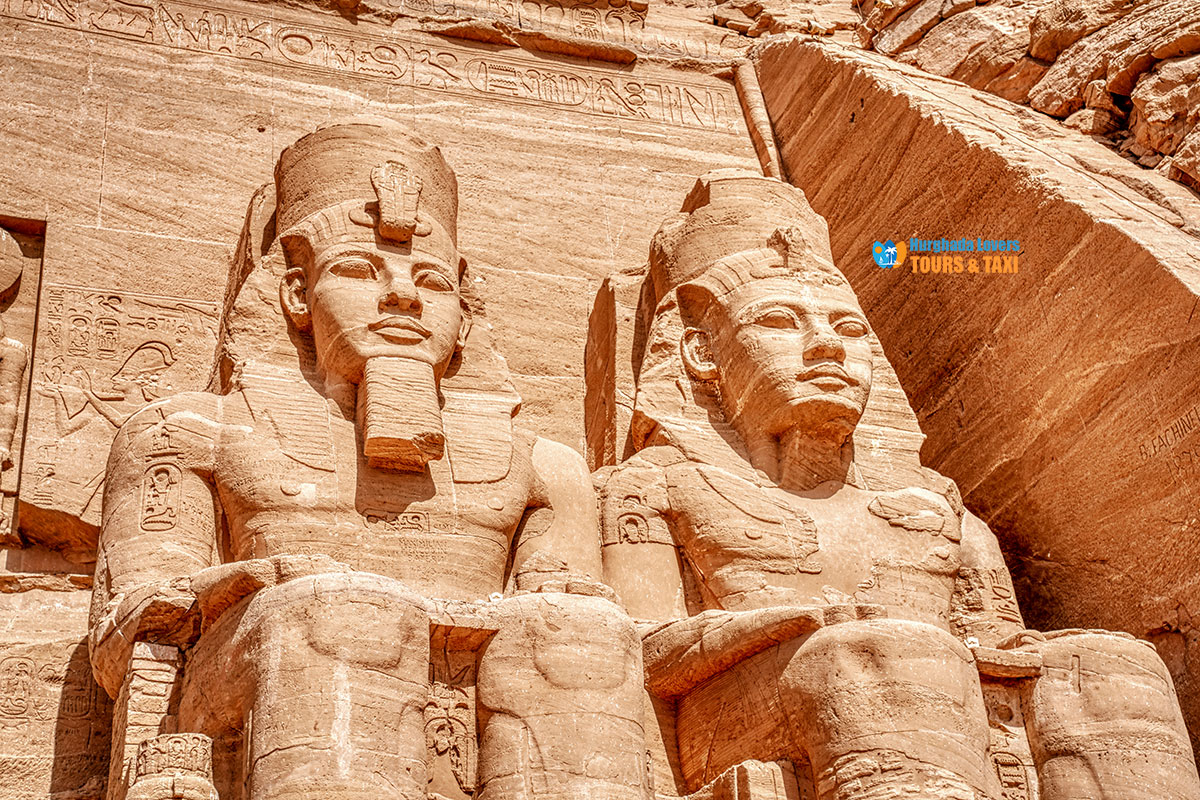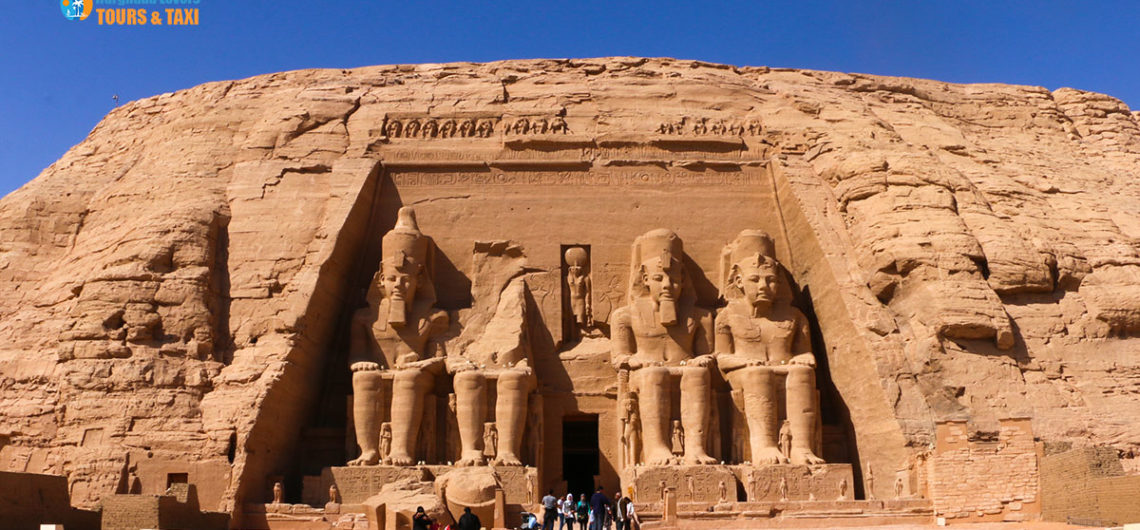Temple of Abu Simbel in Aswan, Egypt – Egyptian Temples
Discover the Ancient Egypt History, the construction of the most important Pharaonic Egyptian Monuments and Egyptian Pharaonic temples in the ancient Egyptian civilization, the secrets of moving the great and small Abu Simbel temples.
the reason for the name and the explanation of the phenomenon of the sun’s perpendicularity twice a year to indicate the development of Astronomy in ancient Egypt and the prices of entrance tickets and visiting hours and more to visit the tourist attractions in Aswan in addition to visiting the tourist attractions in Egypt and learning about Ancient Egypt.
Temple of Abu Simbel Facts
Built: During the reign of King Ramses II “Egyptian Pharaohs kings” of the Nineteenth Dynasty of Egypt in The New Kingdom.
Temple Type: Mortuary Temples.
Beginning of temple construction: 1244 BC
Temple construction period: approximately 21 years
Temple opening date: until 1223 BC
It was built by King Ramses II, one of the famous pharaohs, south of Aswan, towards the village of Abu Simbel.
It is a magnificent temple whose facade is decorated with four seated statues attached to the rock representing the king, indicating the development of Sculpture in Ancient Egypt.
The height of each statue is (21) meters, and the internal columns are distinguished by their human shape, indicating the development of Architecture in ancient Egypt..
Abu Simbel Temple is located on the west bank of the Nile River, 280 km south of Aswan. King Ramses II carved two temples out of rock between 1290 and 1223 BC. The temple is considered one of the architectural engineering miracles of the ancient Egyptians, in addition to how they were able to carve an entire temple inside the rocky mountain..
The Abu Simbel Temple was saved in 1963 and moved to the Abu Simbel Plateau when the construction of the High Dam began.
Abu Simbel Temple is distinguished by the fact that it was not converted into a church or under any other name over the ages and religions. It was discovered in 1817 AD..
Great Temple of Abu Simbel:
The temple is located south of Aswan city. The temple was built during the reign of King Ramses II and dedicated to the worship of the God Horus, sister of the sun god, the most famous of the Egyptian deities – Ancient Egyptian gods and Goddesses, as in the religious beliefs and Ancient Egyptian religion.
The temple is more than 3,000 years old..
The facade of the Abu Simbel Temple is 38m wide and 33m high, where 4 statues of King Ramses II were carved, each 20m high.
In the middle of the facade is an entrance topped by a cavity containing a statue of the god Horus. Then you will see above it a row of statues in the form of monkeys raising their hands to the sun disk..
When you go above the entrance, you will find a statue of a man with a falcon’s head, representing the god Ra-Horakhty.
Then, inside the temple, you will find a hall with a ceiling set on square columns, showing King Ramses II in the form of God Osiris..
You will find engravings showing King Ramses II fighting the Libyans and Hittites in the Battle of Kadesh, indicating the strength and extent of the development of the Military of ancient Egypt.
Then, at the end of the temple, you will find the Holy of Holies.
where you will see a room containing 4 statues of the god Ra-Horakhty, the God Amun–God Ra, the God Ptah, and King Ramses II, as was believed in ancient times in the era of the Pharaohs, in addition to a group of small rooms as a storehouse for the Abu Simbel temple, as in the stories of the Egyptian Mythology and Ancient Egyptian Literature.
Little Abu Simbel Temple:
It is located north of the Great Temple of Abu Simbel, and is carved into the rock of the mountain. It was carved to worship the God Hathor and Queen Nefertari, the wife of King Ramses II, the most famous queen of Pharaonic Egypt “Female Pharaohs“.
It is called the Temple of the Rocks of the Goddess of Love, Music and Beauty, indicating King Ramses II’s interest in developing Music in Ancient Egypt.
You will see a large facade of the temple containing 6 statues divided into three on each side, where you will find two statues of the king and a statue of the queen in the middle, where the height of each statue is 10 meters..
When you go to the temple hall, you will see 6 columns with the head of Hathor, in addition to engravings of the ancient Egyptian goddess, where you will find drawings of King Ramses II and Queen Nefertari during the Battle of Kadesh and other engravings performing religious rituals..
You will see pharaonic engravings of a cow’s head symbolizing Hathor and a statue of King Ramses II carved in the western wall..
The reason for naming the Abu Simbel Temple:
Over time, the sand covered the Abu Simbel Temple up to the knees of the statue of King Ramses II, and the governments were not interested in restoring the temple until 1813 AD..
The Swiss Egyptology and archaeologist J.L. Burckhardt and the Italian Giovanni Belonzi made an unsuccessful attempt to excavate and excavate the entrance to the temple..
Then, the archaeologist Giovanni Belonzi made another attempt in 1817 AD with the help of a Nubian boy named “Abu Simbel” who played the main role in the rapid discovery and reopening of the temple entrance from the quicksand..
Abu Simbel Temple Transfer:
As a result of the construction of the High Dam and Lake Nasser in the city of Aswan, the Abu Simbel Temple was almost completely submerged under the waters of the Nile River..
Egyptian Ministry of Tourism and Antiquities and the Egyptian government, led by the Minister of Antiquities at the time, agreed in 1959 AD to collect international donations with UNESCO to save the archaeological monument..
The process of moving the temple began in 1964 AD..
The cost of moving the entire temple = $40 million.
Temple transfer period = 4 years.
Date of opening of the temple after the transfer = 1968 AD.
The entire Abu Simbel Temple was cut into a very large block, each block weighing 20-30 tons.
Then all parts of the temple were dismantled and reassembled in its new location at an altitude of 65 and 200 meters, higher than the level of the Nile River..
It is interesting that the Mongolian state provided $230 to support the relocation of the temple and protect it from drowning.
At that time, it was a very poor state and collected the money from the people of the Mongolian state..
Abu Simbel Temple Relocation Proposals:
The idea of cutting the temple into precisely numbered parts and blocks belongs to the Egyptian sculptor Ahmed Othman, Dean of the Faculty of Fine Arts at Alexandria University..
France proposed cutting the mountain in half and moving it completely, but it was rejected due to the difficulty of moving the size and weight of the temple at the time in such huge sizes..
Italy made a funny suggestion to make a crystal or rooms of glass and descend through tubes or paths underwater to see the statues, the idea was completely rejected.
Abu Simbel Temple and the Sun’s Perpendicularity:
One of the most important engineering miracles in the Abu Simbel Temple is the sun’s rays falling on the Holy of Holies chamber on two days of each year: February 22, the feast of King Ramses II, and October 22, the feast of the Coronation of the Pharaohs, indicating the development of Ancient Egyptian science“.
The sun’s rays are perpendicular to only three statues, which are of King Ramses II and the statues of the gods Amun and Ra-Harakhty, and are not perpendicular to the god of darkness, Ptah.:.
The Abu Simbel Temple contains a concrete dome with a diameter of about 65 meters and a height of 23 meters to protect the statues..
The temple is not affected by earthquakes up to 10 on the Richter scale..
The sun shines perpendicularly on the Holy of Holies at a distance of about 200 meters only twice a year..
The reason why the sun’s rays do not fall perpendicularly on the statue of the god of darkness, “Ptah”, was believed in the religious beliefs of the ancient Egyptians, that the god Ptah should not be illuminated by the sun’s rays so that the world does not end.
The sun’s rays were discovered perpendicular to the Abu Simbel Temple in 1874 AD..
There is a theory among Egyptologists and archaeologists that October 22nd is the beginning of the season Agriculture in Ancient Egypt and the flooding season for the Pharaohs, and February 22nd of each year is the beginning of the harvest season, so the time of the sun’s rays being perpendicular to the temple was designed at this time every year..
Why was the temple built?:
Commemorating the historic Battle of Kadesh between King Ramses II and his enemies.
The temple was built in southern Egypt in Upper Egypt to protect Egypt from enemies and spread terror and fear among them..
Building a small temple for Queen Nefertari, wife of King Ramses II, in her honor..
Brief introduction to King Ramses II:
Ramses II ruled for 67 years in ancient Egypt, and his reign, along with that of King Pepi II of the Sixth Dynasty of Egypt of the Old Kingdom of Egypt, is the longest reign in Pharaonic history.
This period was confirmed by Manetho and proven by Ostraca, and the stela of King Ramesses IV, the most famous king of the Twentieth Egyptian Dynasty during The Ramesside Period, in which he wishes to rule for a long time, 67 years, like Ramses II “Tomb of King Ramesses II | KV7 is in the Valley of the Kings tombs in Luxor, the archaeological city of Thebes“.
Ramesses II was the third king of a new dynasty, the Nineteenth Dynasty, who took over the throne left vacant by the death of King Horemheb of the Eighteenth Dynasty. King Horemheb (who has the Tomb of Horemheb | KV57 and the Tomb of Horemheb – Saqqara and The Speos Of Horemheb in Aswan).
Horemheb married Queen Ankhesenamun, the widow of King Tutankhamun “He has the Tomb of Tutankhamun | KV62 in the Valley of the Kings, but he died without offspring..
King Ramesses I, founder of the 19th Dynasty, belonged to a family from the eastern Delta, where for generations it had been customary for men to be called sometimes Ramses and sometimes King Seti I, and they worshipped a god who was unloved by all Egyptians, because he was the enemy of Amun and the killer of God Osiris: the God Set, lord of Avaris, the ancient capital of the Hyksos..
Horus name: The strong bull beloved of Maat, The two ladies: He who protects Egypt, He who disciplines foreign lands, The golden Horus: Long-lived, great in victory, The king: The secret of Maat-Ra, strong in the truth of God Ra.
Ra: The chosen one of Ra, and the king is often denied by his fourth name. The son of Ra is Ramessessu Mery-Ameni: Ra is the one who was born by the beloved of God Amun.
Abu Simbel Temple Address:
West Bank of Lake Nasser, Abu Simbel, Aswan, Egypt
Visiting hours and working hours:
Daily 5:00 AM – 6:00 PM
Abu Simbel Temple Entrance Ticket Prices:
Note: Facts and secrets of the history will be added soon…
Hurghada Excursions Lovers, Best Travel Agency in Hurghada to provide daily tours to visit the Tourist attractions of Luxor by Hurghada to Luxor Tours and Hurghada to Pyramids Trips. Book online when you come to Hurghada, El Gouna, Sahl Hashish, Makadi Bay, Soma Bay, Egypt Tours Packages.

